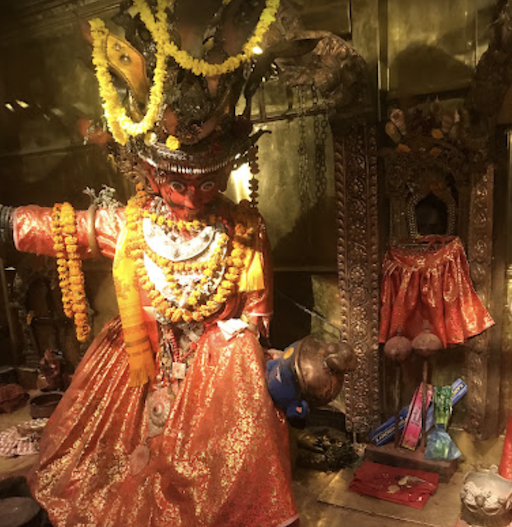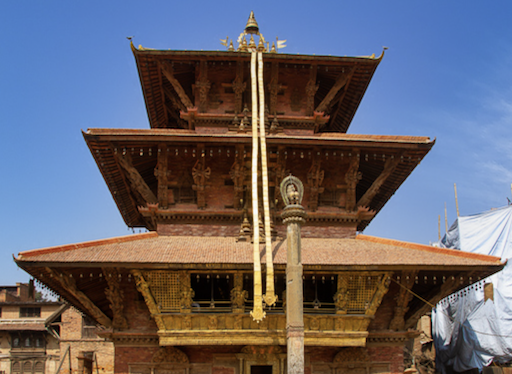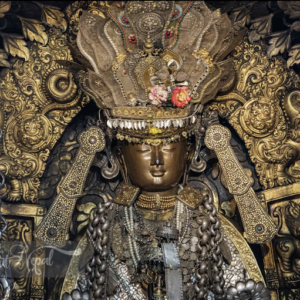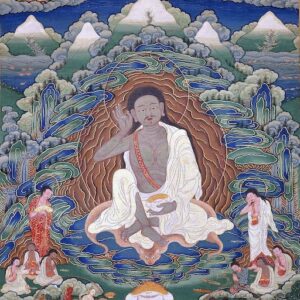This is a consecrated temple of Bhimsen. There is a place to sit and meditate. You can go into meditative states here effortlessly.
How to Get there
It is located near Patan Durbar Square. It is 6 km south west of Tribhuvan International Airport.
Map: https://goo.gl/maps/3xiFs7gU3mDxwPo37
About Bhindyo Temple
The Bhimsen (or Bhimasena) temple is the northernmost of the major monuments in the Mangal Palace square, located directly adjacent to the Vishveshvar (Vishwanath) temple and diagonally opposite the Mani Mandapa pavilions and fountain to the southeast. Dedicated to Bhimsen, the god of trade among the Newars, the monument is of uncertain age but was rebuilt in 1682 by Shrinivas Malla (r. 1661-85) following a fire. Later reconstructions took place in 1934, following the great earthquake, and again in 1967. Although the temple was significantly damaged (though not leveled) in the April 2015 earthquake, it reopened in early 2022 after a thoroughgoing reconstruction that retained much material from its pre-earthquake form.
Like all Bhimsen temples, its ground floor plan is rectangular, with Bhimsen himself residing on the first floor (i.e., one floor above ground level). According to Michael Hutt, the temple is managed by the Kapali-Jogi, a Newar caste of Shaiva renouncers who perform services such as death rituals and religious music for community members. The shrine to Bhimsen, which they maintain, is strictly off-limits to foreigners, who are barred from entering the sanctum via its steep staircase (see image 62), but visitors are otherwise welcome to approach the building’s exterior from all angles.
Bhimsen is traditionally understood as one of five brothers (collectively, the Pandavas) who were fathered by Pandu, as described in the Mahabharata, the ancient Sanskrit epic. However, as Ronald Bernier notes, in Nepal, “…here, he has been elevated to the status of a major god and his image is central to the temple’s main shrine” (Bernier, p. 69). The deity is fashioned with a long skirt, legs astride, cloaked in mail, and grasping a large club. He is helmeted with headgear described as “Grecian.” As noted by Bal Gopal Shreshtha, Newar traders traditionally believe that anyone who can please Bhimsen is compensated with profitable business arrangements, and images of Bhimsen are typically carried to wherever the Newar business community operates. The association of Bhimsen with commerce is, as described by Mary Slusser, an “unexplained metamorphosis” (Slusser, p. 258) from his traditional role as a hero in the Indian tradition, where commerce is generally the realm of Ganesha. She notes that Bhimsen may also be worshiped as a god of love, perhaps due to his affection for Draupadi, the Pandava brothers’ shared wife.
Several features of the Bhimsen temple are unusual. First, it is the only monument in the Mangal palace (Darbar) square decorated with long pataka strips, which traditionally are thought to represent a divine ladder allowing deities to descend to-and-fro from their celestial abode. Second, the east-facing balcony is entirely covered in shiny gilding, including the various wooden brackets that depict Shiva, Parvati, Bhairava, and Ganesh. Finally, each roof tier is given its own metal finials; while not unusual, it is not a standard feature. As noted by Michael Hutt, one other unusual aspect is that the dedicatory inscription from Srinivas Malla’s period records all three of the valley’s kingdoms (Patan/Lalitpur, Kathmandu, and Bhaktapur) were at peace—a rare enough occurrence that it was worth memorializing.
Source
https://www.orientalarchitecture.com/sid/1628/nepal/patan/bhimsen-temple-of-lalitpur
This is a consecrated temple of Bhimsen. There is a place to sit and meditate. You can go into meditative states here effortlessly.
How to Get there
It is located near Patan Durbar Square. It is 6 km south west of Tribhuvan International Airport.
Map: https://goo.gl/maps/3xiFs7gU3mDxwPo37
About Bhindyo Temple
The Bhimsen (or Bhimasena) temple is the northernmost of the major monuments in the Mangal Palace square, located directly adjacent to the Vishveshvar (Vishwanath) temple and diagonally opposite the Mani Mandapa pavilions and fountain to the southeast. Dedicated to Bhimsen, the god of trade among the Newars, the monument is of uncertain age but was rebuilt in 1682 by Shrinivas Malla (r. 1661-85) following a fire. Later reconstructions took place in 1934, following the great earthquake, and again in 1967. Although the temple was significantly damaged (though not leveled) in the April 2015 earthquake, it reopened in early 2022 after a thoroughgoing reconstruction that retained much material from its pre-earthquake form.
Like all Bhimsen temples, its ground floor plan is rectangular, with Bhimsen himself residing on the first floor (i.e., one floor above ground level). According to Michael Hutt, the temple is managed by the Kapali-Jogi, a Newar caste of Shaiva renouncers who perform services such as death rituals and religious music for community members. The shrine to Bhimsen, which they maintain, is strictly off-limits to foreigners, who are barred from entering the sanctum via its steep staircase (see image 62), but visitors are otherwise welcome to approach the building’s exterior from all angles.
Bhimsen is traditionally understood as one of five brothers (collectively, the Pandavas) who were fathered by Pandu, as described in the Mahabharata, the ancient Sanskrit epic. However, as Ronald Bernier notes, in Nepal, “…here, he has been elevated to the status of a major god and his image is central to the temple’s main shrine” (Bernier, p. 69). The deity is fashioned with a long skirt, legs astride, cloaked in mail, and grasping a large club. He is helmeted with headgear described as “Grecian.” As noted by Bal Gopal Shreshtha, Newar traders traditionally believe that anyone who can please Bhimsen is compensated with profitable business arrangements, and images of Bhimsen are typically carried to wherever the Newar business community operates. The association of Bhimsen with commerce is, as described by Mary Slusser, an “unexplained metamorphosis” (Slusser, p. 258) from his traditional role as a hero in the Indian tradition, where commerce is generally the realm of Ganesha. She notes that Bhimsen may also be worshiped as a god of love, perhaps due to his affection for Draupadi, the Pandava brothers’ shared wife.
Several features of the Bhimsen temple are unusual. First, it is the only monument in the Mangal palace (Darbar) square decorated with long pataka strips, which traditionally are thought to represent a divine ladder allowing deities to descend to-and-fro from their celestial abode. Second, the east-facing balcony is entirely covered in shiny gilding, including the various wooden brackets that depict Shiva, Parvati, Bhairava, and Ganesh. Finally, each roof tier is given its own metal finials; while not unusual, it is not a standard feature. As noted by Michael Hutt, one other unusual aspect is that the dedicatory inscription from Srinivas Malla’s period records all three of the valley’s kingdoms (Patan/Lalitpur, Kathmandu, and Bhaktapur) were at peace—a rare enough occurrence that it was worth memorializing.
Source
https://www.orientalarchitecture.com/sid/1628/nepal/patan/bhimsen-temple-of-lalitpur
This is a consecrated temple of Bhimsen. There is a place to sit and meditate. You can go into meditative states here effortlessly.
How to Get there
It is located near Patan Durbar Square. It is 6 km south west of Tribhuvan International Airport.
Map: https://goo.gl/maps/3xiFs7gU3mDxwPo37
About Bhindyo Temple
The Bhimsen (or Bhimasena) temple is the northernmost of the major monuments in the Mangal Palace square, located directly adjacent to the Vishveshvar (Vishwanath) temple and diagonally opposite the Mani Mandapa pavilions and fountain to the southeast. Dedicated to Bhimsen, the god of trade among the Newars, the monument is of uncertain age but was rebuilt in 1682 by Shrinivas Malla (r. 1661-85) following a fire. Later reconstructions took place in 1934, following the great earthquake, and again in 1967. Although the temple was significantly damaged (though not leveled) in the April 2015 earthquake, it reopened in early 2022 after a thoroughgoing reconstruction that retained much material from its pre-earthquake form.
Like all Bhimsen temples, its ground floor plan is rectangular, with Bhimsen himself residing on the first floor (i.e., one floor above ground level). According to Michael Hutt, the temple is managed by the Kapali-Jogi, a Newar caste of Shaiva renouncers who perform services such as death rituals and religious music for community members. The shrine to Bhimsen, which they maintain, is strictly off-limits to foreigners, who are barred from entering the sanctum via its steep staircase (see image 62), but visitors are otherwise welcome to approach the building’s exterior from all angles.
Bhimsen is traditionally understood as one of five brothers (collectively, the Pandavas) who were fathered by Pandu, as described in the Mahabharata, the ancient Sanskrit epic. However, as Ronald Bernier notes, in Nepal, “…here, he has been elevated to the status of a major god and his image is central to the temple’s main shrine” (Bernier, p. 69). The deity is fashioned with a long skirt, legs astride, cloaked in mail, and grasping a large club. He is helmeted with headgear described as “Grecian.” As noted by Bal Gopal Shreshtha, Newar traders traditionally believe that anyone who can please Bhimsen is compensated with profitable business arrangements, and images of Bhimsen are typically carried to wherever the Newar business community operates. The association of Bhimsen with commerce is, as described by Mary Slusser, an “unexplained metamorphosis” (Slusser, p. 258) from his traditional role as a hero in the Indian tradition, where commerce is generally the realm of Ganesha. She notes that Bhimsen may also be worshiped as a god of love, perhaps due to his affection for Draupadi, the Pandava brothers’ shared wife.
Several features of the Bhimsen temple are unusual. First, it is the only monument in the Mangal palace (Darbar) square decorated with long pataka strips, which traditionally are thought to represent a divine ladder allowing deities to descend to-and-fro from their celestial abode. Second, the east-facing balcony is entirely covered in shiny gilding, including the various wooden brackets that depict Shiva, Parvati, Bhairava, and Ganesh. Finally, each roof tier is given its own metal finials; while not unusual, it is not a standard feature. As noted by Michael Hutt, one other unusual aspect is that the dedicatory inscription from Srinivas Malla’s period records all three of the valley’s kingdoms (Patan/Lalitpur, Kathmandu, and Bhaktapur) were at peace—a rare enough occurrence that it was worth memorializing.
Source
https://www.orientalarchitecture.com/sid/1628/nepal/patan/bhimsen-temple-of-lalitpur




